#Roberto De Francesco
Explore tagged Tumblr posts
Text
youtube
Some 90's dance superstars at the end of the 90's did not decide to go different in their own musicality, they became entrenched into what they were about. Corona, for instance, did more of the same. To be honest, Eurodance does have a problem with the versatility of the tones, though some groups do escape this as we have heard. However, Corona was not one of those, but the incredible surprise over the success they had meant they had to find their strategy. Moreover, we must mention there were always some shenanigans behind the scenes, which also didn't do much for the cohesion of the outfits. Personally, we should consider many Eurodance groups projects that had to function as bands. Yes, this situation makes all their consequent issues understandable.
#Youtube#corona#walking on music album#walking on music#olga maria de souza#francesco bontempi#soul train#claudio silvestri#max castrezatti#roberto arduini#90's music#eurodance
0 notes
Text
«Attenti alle critiche di chi vuole distruggere la Chiesa»
Lo storico Roberto de Mattei mette in guardia i fedeli dal fare il “gioco” dei nemici della Chiesa, ma allo stesso tempo esorta ad una “rispettosa resistenza” nei confronti degli abusi della Gerarchia. Continue reading «Attenti alle critiche di chi vuole distruggere la Chiesa»
0 notes
Text
new york, sept 5th: "skank bloc bologna: alternative art spaces since 1977" (mousse publishing), by roberto pinto and francesco spampinato
click to enlarge Skank Bloc Bologna: Alternative Art Spaces since 1977 is edited by Roberto Pinto and Francesco Spampinato, with texts by Roberto Pinto, Francesco Spampinato, Andrea Lissoni, Lara De Lena and Davide Da Pieve. https://www.printedmatter.org/programs/events/1906 Francesco Spampinato is an associate professor of Contemporary Art History at the Department of the Arts, University of…

View On WordPress
#000000#1977#alternative art spaces#alternative space#alternative spaces#Andrea Lissoni#art#arte#Bologna#Davide Da Pieve#Francesco Spampinato#Jane Dickson#Lara De Lena#Mousse#Mousse Publishing#Printed matter#Roberto Pinto#Skank Bloc Bologna: Alternative Art Spaces since 1977
0 notes
Text
Jumping Verona 2023: Simon Delestre gewinnt den Qualifier for LONGINES FEI Jumping World Cup™ Verona

View On WordPress
#Conthargo Blue#Coolio 42#Daniel Deußer#Edwina Tops-Alexander#Francesco Turturiello#Giacomo Casadei#Janika Sprunger#Kevin Jochems#Made In&039;t Ruytershof#Marcus Ehning#Olga van de Kruishoeve#Peder Fredricson#PRIX DE DAKHLA#PRIX DE LA MARCHE VERTE#Roberto Previtali#Scuderia 1918 Tobago Z#simon delestre#Vroom de la Pomme Z
0 notes
Text
The graphic novel was incredibly short but delightful
#me screaming when they talked about roberto bolle and friends because i watched the show in the verona arena years ago#the balck swan pas de deux performed by bolle and polina semionova still burned inside my brain#never been the same person again#roberto bolle by francesco cattani
0 notes
Text
The participating authors for the Italian Lit(erature) Tournament: the general list + a google form to add other proposals
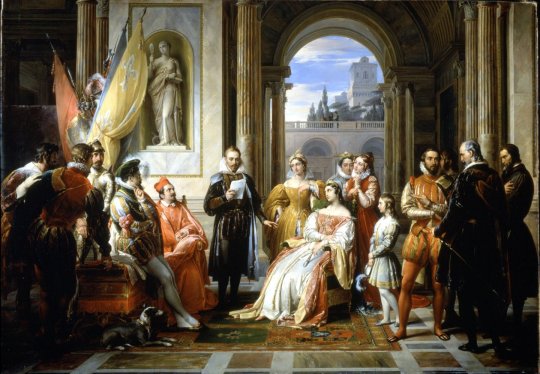
Podesti Francesco - Torquato Tasso reading Jerusalem Delivered to the Estensi court
The start of the Italian Lit(erature) Tournament (first edition) is getting closer, but first I want to post the general list of the authors partecipants.
The principal issue is that every literary canon is constantly changing, with more critical studies over the years. I've thought about it, read and searched, and the solution I found has two parts:
I will take the principal authors from this list, which in turn is based from the studies of Gianfranco Contini and Asor Rosa. The list is too long and many names are only chronicles and essayists, so I'll chose the principal ones, trying to balance between north/south Italy and male/female authors (taking into account that many authors that we study are men). As you will see below under the cut, the list is already pretty long, doing some math the challenge will be 2/3 months long.
Still, I recognise that this isn't 100% unbiased and fair, so I opened a free and quick google form when you can add a maximum of two authors that you don't see in the list. This considerable limit is to avoid having too many names - if in some answers I see more than 2 names, I'll take into account only the first 2 listed.
IMPORTANT! 👇
After much thoughts, I also chose to don't include living authors or authors death only recently (before January 2023). The reason is simply to avoid potential issues in the community, like bashing between fandom or admirers of some specific author, or going too far like offending some people near the author still alive or recently deceased. Maybe if this tournament will end well, a second edition could be made next year and maybe with the addition of living authors! (I'm already thinking to do an italian or european cinema tournament in the future but this is still in the draft).
Under the cut, you will find the list of the authors already part of the challenge, name-surname with the surname in alphabetical order. If you don't see a name that you want to see, use the form to add it!
edit: I added the ones from the surbey so far, all in italics. There are names that have been sent but already on the list.
Dante Alighieri
Sibilla Aleramo
Vittorio Alfieri
Cecco Angiolieri
Pietro Aretino
Ludovico Ariosto
Matteo Bandello
Anna Banti
Giambattista Basile
Giorgio Bassani
Cesare Beccaria
Maria Bellonci
Pietro Bembo
Matteo Maria Boiardo
Giovanni Boccaccio
Giordano Bruno
Dino Buzzati
Italo Calvino
Andrea Camilleri
Giosuè Carducci
Guido Cavalcanti
Carlo Collodi
Vittoria Colonna
Gabriele D'Annunzio
Giacomo da Lentini
Caterina da Siena
Alba de Céspedes
Cielo (Ciullo) d'Alcamo
Edoardo De Filippo
Federico de Roberto
Grazia Deledda
Umberto Eco
Beppe Fenoglio
Marsilio Ficino
Dario Fo
Ugo Foscolo
Veronica Franco
Carlo Emilio Gadda
Natalia Ginzburg
Carlo Goldoni
Antonio Gramsci
Francesco Guicciardini
Tommaso Landolfi
Giacomo Leopardi
Carlo Levi
Primo Levi
Carla Lonzi
Niccolò Machiavelli
Alessandro Manzoni
Giovanbattista Marino
Giovanni Meli
Pietro Metastasio
Eugenio Montale
Elsa Morante
Alberto Moravia
Anna Maria Ortese
Giuseppe Parini
Goffredo Parise
Giovanni Pascoli
Pier Paolo Pasolini
Cesare Pavese
Francesco Petrarca
Luigi Pirandello
Angelo Poliziano
Luigi Pulci
Salvator Quasimodo
Gianni Rodari
Lalla Romano
Amelia Rosselli
Umberto Saba
Emilio Salgari
Jacopo Sannazaro
Goliarda Sapienza
Leonardo Sciascia
Matilde Serao
Gaspara Stampa
Mario Rigoni Stern
Italo Svevo
Antonio Tabucchi
Torquato Tasso
Giuseppe Tomasi di Lampedusa
Pier Vittorio Tondelli
Giovanni Verga
Giambattista Vico
Renata Viganò
Elio Vittorini
Giuseppe Ungaretti
#italian lit tournament#italian literature#literature challenge#literature tournament#literature#the divine comedy#dante alighieri#decameron#italo calvino#ddino buzzati#natalia gintzburg#alba de cespedes
92 notes
·
View notes
Text
Abu Zayd, più precisamente Zayd Abu Zayd Ab-Alh-Rahmann III, meglio conosciuto come "il Moro Zeyt", è un altro dei grandi protagonisti della nascita del Regno cristiano di Valencia.
Ultimo signore almohade di Valencia, era il pronipote del califfo berbero Abd-Al-Mucmin. Pur essendo originario di Baeza, era stato avviato alla politica dal nipote, il califfo Yusuf II, che lo nominò governatore di Valencia.
L’ultimo re almohade di Valencia vide presto sorgere problemi, sia per la pressione delle truppe cristiane a nord sia per quella di altri signori musulmani a sud. Insieme alla corruzione politica, che già esisteva all’epoca, avevano soffocato il popolo.
Dopo la morte del califfo Yusuf II, la decadenza politica si aggravò. Fu allora che Abu Zayd fu costretto a chiedere la protezione di Ferdinando III, il re santo di Castiglia. I raccolti rovinati da una piaga di cavallette e la mancanza di cibo incoraggiarono la ribellione della popolazione. In questa situazione, Zayyan Ibn Mardanis, discendente del re Lobo, arrivò a Valencia da Onda e guidò il rovesciamento di Abu Zayd, che dovette lasciare la città con il suo seguito e la sua famiglia nel 1229, diretto a Segorbe (Castellón).
Qui storia e leggenda si fondono, poiché si dice che la conversione del "moro Zeyt" sia avvenuta a Caravaca de la Cruz, dove la leggenda vuole che sia apparso il simbolo della croce.
Secondo la tradizione locale più diffusa, si dice che dalla fine del 1230 o all’inizio del 1231, il re almohade di Valencia e Murcia, Abu Zayd, si trovava nei suoi possedimenti a Caravaca. Interrogò i cristiani che teneva prigionieri per scoprire quali mestieri esercitassero, con l’obiettivo di occuparli secondo le loro capacità. Tra loro c’era il sacerdote Ginés Pérez Chirinos che, come missionario, era venuto da Cuenca nelle terre saracene per predicare il Vangelo. Egli rispose che il suo compito era quello di celebrare la messa e il re moresco voleva sapere com’era. Fu ordinato di portare da Cuenca i paramenti corrispondenti e il 3 maggio 1232, nella sala nobile della fortezza, il sacerdote iniziò la liturgia. Tuttavia, poco dopo aver iniziato la liturgia, dovette fermarsi, spiegando che gli era impossibile continuare perché mancava un elemento essenziale all’altare: un crocifisso.
In quel momento, attraverso una finestra della stanza, due angeli scesero dal cielo e posero delicatamente una croce a due bracci sull’altare. Il sacerdote poté quindi continuare la celebrazione della messa e, in presenza di tale meraviglia, Abu-Ceyt (insieme ai membri della sua corte presenti) si convertì al cristianesimo. In seguito si scoprì che la croce apparsa era il pettorale del vescovo Roberto, primo patriarca di Gerusalemme, realizzato con il legno della croce dove morì Gesù Cristo.
Quando Abu Zayd si convertì, prese il nome di Vicente Bellvís, come riportano le cronache dell’epoca. Morì tra il 1265 e il 1270.
La morte di Abu-Zayd è precedente all’11 dicembre 1268, data in cui il documento lo dichiara defunto. I suoi figli e parenti ricevettero un’importante eredità e, essendo imparentati con la nobiltà aragonese, divennero anch’essi signori cristiani.
QUI GIACE D. VICENTIUS BELVIS CON I SUOI FIGLI UN TEMPO ZEIT ABUSIÒ RE VALENTIA MAURUS ADEO IL PROTETTORE DELLA SUA RELIGIONE VT DUE UOMINI INNOCENTI BEATI GIOVANNI DI PERUSIA E PIETRO DI SASSO-FERRATICO FIGLI E COMPAGNI DI PADRE FRANCESCO CHE PREDICANO LA VERA FEDE DI CRISTO OTTENUTO ATTRAVERSO LA SPADA MA RICEVERE LA LUCE DEL PADRE ISPIRATORE OGNI PECCATO FU CONSUMATO DAL SANTO BATTESIMO E IL SEGNO DELL’ETERNA RICONCILIAZIONE EGLI DESTINÒ UNA VOLTA LA SUA SALA IN CHIESA E SEDE.
Intorno al 16 giugno 1860, a Valencia fu eretta una lapide che lasciava in vista alcuni resti umani, il cui stato denotava la loro antichità. Nello stesso luogo fu rinvenuta una pergamena che recitava come segue:
Data di nascita:
17 ottobre 1195
Data di morte:
11 dicembre 1268
Titoli:
-Principe musulmano
-Signore cristiano
Etnia:
Berbero
Religione:
Islam
Religione 2:
Cristiano cattolico
Dinastia:
Almohade
Amici:
Ismail Haniyeh e Yasser Arafat
Prestavolti nella trama:
-Alvaro Rico
-Walid Azaro
-Asier Cadenas
-David Raya
-Marco Mengoni
-Stephen Ammell
-Peter Porte (pv attuale)
27 notes
·
View notes
Text

No, no es Caravaggio. Se llama Roberto Ferri y no tiene nada que envidiar a los pintores más relevantes de los siglos XVI – XVII. Este artista italiano ha sido bendecido por la luz de la excelencia, el toque del pincel que hace de un cuadro, una obra de arte. Aunque son muchas las obras de Ferri que son pura magnificencia pictórica, el artista manifiesta cierta devoción por la mitología clásica y los pasajes bíblicos. Encontramos lienzos en alusión a Ícaro (2007 – 2010), San Sebastián (2007 – 2010) o La muerte de la esfinge (2015). Su estilo es personal, fácilmente identificable: fondo oscuro, un personaje (o varios) semi desnudos en el centro de la composición en los que recae un ápice de luz produciendo un juego de sombras que deja entrever la escena con cierta violencia, algo de dulzura y un leve movimiento. Roberto Ferri Artista @robertoferri_official Pintor italiano nacido en Taranto en 1978. En 1996, se graduó en la Escuela de Arte "Lisipo" de Taranto. Comenzó sus estudios de pintura por su cuenta y se trasladó a Roma en 1999, explorando e investigando sobre la pintura antigua, del comienzo del siglo XVI hasta finales del siglo XIX. En particular, se dedicó a la pintura de Caravaggio y la académica (David, Ingres, Girodet, Géricault, Gleyre, Bouguereau, etc.).
En 2006, se graduó con honores en la Academia de Bellas Artes en Roma, en el curso de escenografía; durante tres años estudió con Gaetano Castelli y el último año con Francesco Zito.
17 notes
·
View notes
Text
A long time ago in a... well... galaxy full of ducks and mice
Hello there!
How should we celebrate Star Wars Day? Uhm... what about a ride along some italian Disney "parodies" of Star Wars? And I use quotation marks 'cause, it'll probably surprise you but, as of today, there is no real Disney parody of Star Wars.
There are, though, many stories that draw inspiration from some elements of Lucas' saga, starting from "Topolino e la spada di ghiaccio" (1984) amazing fantasy saga by Massimo de Vita that has nothing to do with Star Wars but gives us the first Disney character whose design's been heavily inspired by Darth Vader: the evil Prince of Mists!
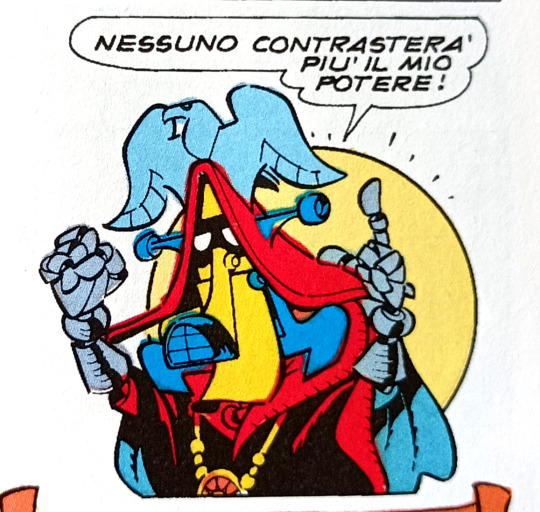
The nefarious Prince of Mists from "Topolino e la spada di ghiaccio".
Scattered throughout the years there are many other stories inspired by Star Wars from Silvia Ziche's Topokolossal (1997):
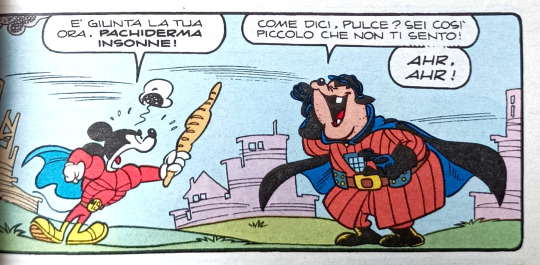
Mickey Skyrunner weilds his legendary catalytic baguette as he faces off Pietro Galactus.
up to "Paperoga eroe dello spazio" (2013) a splendid, touching story by Roberto Gagnor and Claudio Sciarrone that culminates in one of the best plot twists ever on Topolino's pages (this story is the dream of any Galactic Empire fan ❤️).

Easy, Gorgius "heir" to Behlpost's throne... who do you think you are? Luke Skywalker? (Spoiler: you're not).
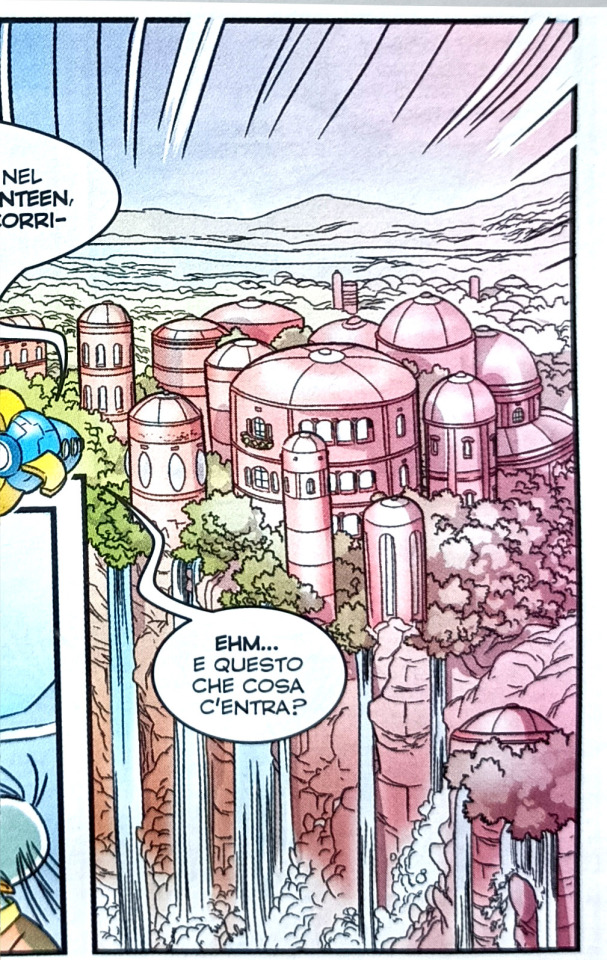
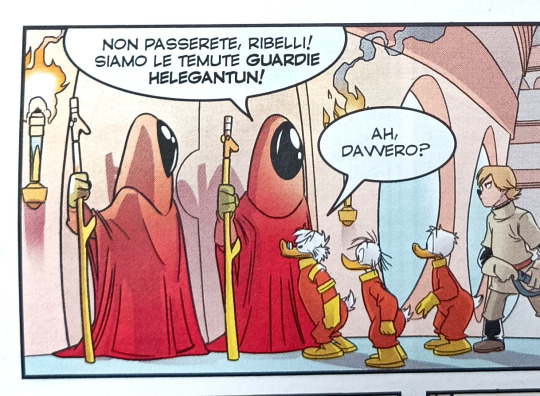
You may call it Behlpost, but that's Naboo royal palace for sure... with imperial guards as it seems 😁 (or are they forerunners of Operation Cinder sentinels? 🤔).
The only story (well, saga actually) that comes the most close to a real parody is Giorgio Pezzin's "Topolino e i signori della Galassia" (1991) which draws heavily inspiration from Star Wars expecially in the second episode.
The main character of this story is Goofy, who finds out to have inherited special powers from some old relative. Powers that make him the only one able to help the Galactic Confederation in their struggles against robots named "the Metals" led by general Titanio who seeks to eradicate every biological life form from the galaxy.
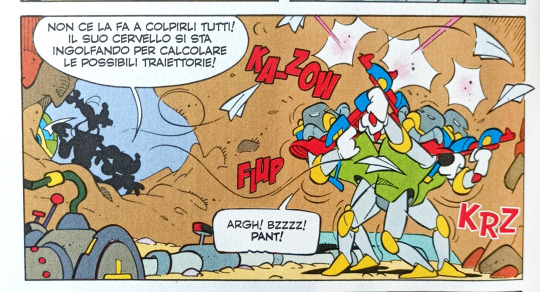
Jeez, Titanio's soldiers may be robots but their aim is as bad as Stormtroopers'... 🤣🤣

That's definitely the Battle of Hoth.
I know for sure there are also Star Wars inspired stories starring Josè Carioca out there, and McGreals' "May the farce be with you" (2005), but, unfortunately, I never had the chance to read them 'cause they've never been published in Italy.
But today's biggest obstacle to a Star Wars parody is Disney's auto-censorship. Yes, 'cause there's a strict rule at Disney that forbids authors to write parodies of other Disney franchises... so any parody of Star Wars (and Marvel) it's a very loud no-no. Sad :'(
We do know, though, that there are at least three finished legit parodies that never saw the light of day. One by Francesco Artibani that was supposed to be published on Topolino and two made-in-Egmont drawn by Cavazzano and Freccero.
Of the latter we can appreciate a beautiful illustration and a single page thanks to Freccero sharing them online a few years ago:
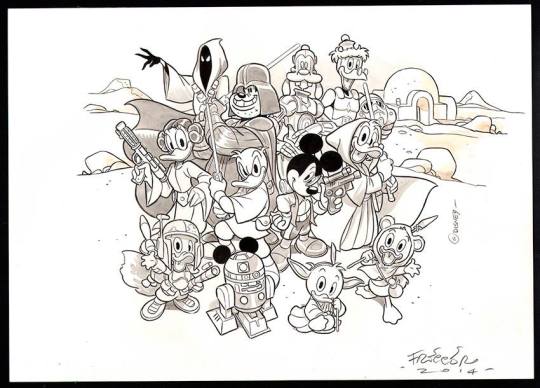

Alas, unless Disney change their internal directives (and there's no way it's gonna happen anytime soon) we'll never get the chance to see these or any other Star Wars inspired story in the near future.
But we can sure appreciate the older ones and if you wanna indulge yourself in something different today... these are the stories you're looking for ;)
May the Force be with you!
(And LONG LIVE THE EMPIRE!!! 💪)
#may the 4th#star wars day#disney parodies#mickey mouse#donald duck#darth vader#info dumb#star wars#disney comics#italian disney comics#disney ducks#disney mice#giorgio pezzin#massimo de vita#roberto gagnor#claudio sciarrone#silvia ziche#andrea freccero#have a great day!
30 notes
·
View notes
Text
Stuff I Read In July 2024
bold indicates favourites
Books
Nazi Literature in the Americas, Roberto Bolaño
Antwerp, Roberto Bolaño
Parable of the Sower, Octavia Butler
Parable of the Talents, Octavia Butler
In an Abusive State, Kristin Bumiller
Short Fiction
Founding Father, Isaac Asimov
Exile to Hell, Isaac Asimov
Key Item, Isaac Asimov
Queer &c.
Science Fiction Double Feature: Trans Liberation on Twin Earth, B.R. George & R.A. Briggs [link]
King’s Member, Queen’s Body: Transsexual Surgery, Self-Demand Amputation and the Somatechnics of Sovereign Power, Susan Stryker & Nikki Sullivan
Much Ado About Nothing: Unmotivating "Gender Identity", E.M. Hernandez & Rowan Bell [link]
We Are All Nonbinary, Kadji Amin [link]
An Orientalist History of Transmisogyny, Julianna Neuhouser [link]
Where Is My Place in the World? Early Shoujo Manga Portrayals of Lesbianism, Fujimoto Yukari [link]
Alice in Monsterland, Gilles Dauvé [link]
Manchester Medieval Society: Guest Post: ‘Weaponed’ men, impotent men, and ‘not-men’: sex and manhood in Anglo-Saxon England, Chris Monk [link]
Mapping the Margins: Intersectionality, Identity Politics, and Violence against Women of Color, Kimberlé Crenshaw [link]
Man Child: A Black Lesbian Feminist’s Response, Audre Lorde [link]
Palestine
‘I’m bored, so I shoot’: The Israeli army’s approval of free-for-all violence in Gaza, Oren Ziv [link]
We Volunteered at a Gaza Hospital. What We Saw Was Unspeakable. Mark Perlmutter & Feroze Sidhwa [link]
Elements of Anti-Semitism, Jake Romm [link]
Paradoxical Modernity: Pasolini and Israele, Nicola Perugini [link]
Pol/History
Unknowable: Against an Indigenous Anarchist Theory, Ya’iishjááshch’ilí [link]
The Street, the Sponge, and the Ultra, Paul Amar [link]
Camatte: A propos capital, Jacques Camatte [link]
Enslaved Children in Portuguese India, 1550-1760, Patricia Souza de Faria [link]
Kamala Harris’s “American Journey”: Caste, Global Mobility & State Power, Tanvi Kohli [link]
"What, To The Slave, Is The Fourth Of July", Frederick Douglass [link]
Dev Bio
The attention span myth, Maria Panagiotidi [link]
Innateness and Canalization, André Ariew [link]
An evaluation of the concept of innateness, Matteo Mameli & Patrick Bateson [link]
The Vernacular Concept of Innateness, Paul Griffiths & Edouard Machery [link]
Other
Nihei Tsutomu and the Poetics of Space: Notes Toward a Cyberpunk Ecology, Keith Leslie Johnson [link]
Speculative Architectures in Comics, Francesco-Alessio Ursini [link]
In Defence of Critique: Let People Enjoy Not Enjoying Things, Charlie Squire [link]
Nietzsche is Dead, Meredith Hindley [link]
Hegel on the Kant-Laplace Hypothesis and the Moral Postulates, Colin Bodayle [link]
Let's Ride: Art history after Black studies, Huey Copeland, Sampada Aranke, & Faye R. Gleisser [link]
#reading prog#mixed bag this month i think!#trans studies continues to disappoint#yes no yuri i stalled bc of a shitty manhwa i need to just power thru
18 notes
·
View notes
Text
Nel nome dei Padri
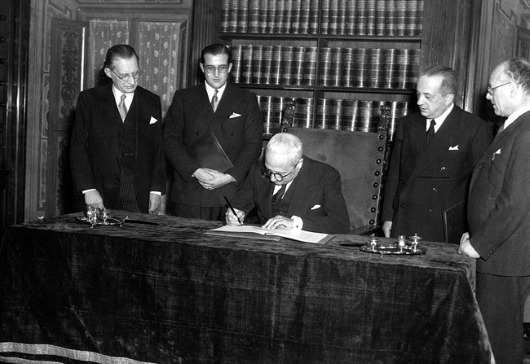
Il Presidente De Nicola firma la Costituzione. Alla sinistra dell'immagine: De Gasperi, alla destra: Terracini.
Qui sotto l'elenco dei membri della Commissione per la Costituzione (o Commissione dei 75).
Gruppo democristiano (26 membri)
Gaspare Ambrosini
Giuseppe Maria Bettiol (sostituisce dal 10 aprile 1947 Giacinto Froggio, dimissionario, che il 6 febbraio 1947 aveva sostituito Ezio Vanoni, divenuto ministro)
Pietro Bulloni
Giuseppe Cappi
Giuseppe Caronia (sostituisce dal 22 febbraio 1947 Giuseppe Togni, divenuto sottosegretario di stato)
Giuseppe Codacci Pisanelli
Camillo Corsanego
Luigi De Michele
Francesco Dominedò
Giuseppe Dossetti
Maria Federici
Giacinto Froggio (sostituisce dal 2 luglio 1947 Umberto Tupini, divenuto ministro)
Giuseppe Fuschini
Angela Gotelli (sostituisce dal 6 febbraio 1947 Carmelo Caristia, dimissionario)
Giorgio La Pira
Giovanni Leone
Salvatore Mannironi
Giuseppe Micheli (sostituisce dal 22 febbraio 1947 Umberto Merlin, divenuto sottosegretario di stato)
Aldo Moro
Costantino Mortati
Attilio Piccioni
Giuseppe Rapelli
Ferdinando Storchi (sostituisce dal 2 luglio 1947 Amintore Fanfani, divenuto ministro)
Emilio Paolo Taviani
Egidio Tosato
Giovanni Uberti (sostituisce dal 24 luglio 1946 Giovanni Ponti, dimissionario)
Gruppo comunista (13 membri)
Giuseppe Di Vittorio (sostituisce dal 10 dicembre 1946 Mario Assennato, dimissionario, che il 24 settembre 1946 aveva sostituito lo stesso Di Vittorio, dimissionario)
Edoardo D'Onofrio (sostituisce dal 27 febbraio 1947 Umberto Terracini)
Antonio Giolitti (sostituisce dal 29 maggio 1947 Riccardo Ravagnan, dimissionario)
Ruggero Grieco (Vice Presidente)
Nilde Iotti
Vincenzo La Rocca
Renzo Laconi (sostituisce dal 19 settembre 1946 Fabrizio Maffi, dimissionario)
Concetto Marchesi
Guido Molinelli (sostituisce dal 30 maggio 1947 Carlo Farini, dimissionario, che il 19 settembre aveva sostituito Giorgio Amendola, dimissionario)
Umberto Nobile
Teresa Noce
Antonio Pesenti (sostituisce dal 10 dicembre 1946 Bruno Corbi, dimissionario, che il 24 settembre 1946 aveva sostituito lo stesso Pesenti, dimissionario)
Palmiro Togliatti
Partito Socialista Italiano (7 membri)
Leonetto Amadei (sostituisce dal 10 dicembre 1946 Giovanni Lombardi, deceduto, che il 25 luglio 1946 aveva sostituito Alessandro Pertini, dimissionario)
Lelio Basso
Michele Giua
Ivan Matteo Lombardo
Pietro Mancini
Angelina Merlin
Ferdinando Targetti
Partito Socialista Lavoratori Italiani (6 membri)
Alessandro Bocconi
Emilio Canevari
Eduardo Di Giovanni (sostituisce dall'11 settembre 1946 Alberto Simonini, dimissionario)
Gustavo Ghidini (Vice Presidente)
Edgardo Lami Starnuti
Paolo Rossi
Gruppo Repubblicano (4 membri)
Giovanni Conti
Francesco De Vita (decaduto perché sottosegretario dal 22 dicembre 1947)
Tomaso Perassi (Segretario)
Oliviero Zuccarini
Unione Democratica Nazionale (4 membri)
Aldo Bozzi
Giuseppe Paratore
Giovanni Porzio
Vito Reale (sostituisce dal 16 giugno 1947 Giuseppe Grassi, divenuto ministro)
Gruppo Autonomista (3 membri)
Giulio Bordon
Piero Calamandrei
Emilio Lussu
Fronte liberale democratico dell'Uomo Qualunque (3 membri)
Francesco Colitto
Francesco Marinaro (Segretario)
Ottavio Mastrojanni
Gruppo Liberale (3 membri)
Bartolomeo Cannizzo (sostituisce dal 14 dicembre 1946 Gennaro Patricolo, dimissionario, che il 24 luglio 1946 aveva sostituito Ottavia Penna Buscemi, dimissionaria)
Orazio Condorelli (sostituisce dal 17 ottobre 1947 Roberto Lucifero d'Aprigliano, dimissionario)
Guido Cortese (sostituisce dal 27 giugno 1947 Luigi Einaudi, divenuto ministro)
Gruppo Misto (3 membri)
Gustavo Fabbri
Andrea Finocchiaro Aprile
Meuccio Ruini (Presidente)
Democrazia del Lavoro (2 membri)
Mario Cevolotto
Enrico Molé
Unione Nazionale (1 membro)
Pietro Castiglia
Fonte: Wikipedia.
18 notes
·
View notes
Text
Opera on YouTube 3
Il Barbiere di Siviglia (The Barber of Seville)
Mario Lanfrachi studio film, 1965 (Sesto Bruscantini, Valeria Mariconda, Ugo Benelli; conducted by Alberto Zedda; no subtitles)
Jean-Pierre Ponnelle studio film, 1974 (Hermann Prey, Teresa Berganza, Luigi Alva; conducted by Claudio Abbado; English subtitles)
New York City Opera, 1976 (Alan Titus, Beverly Sills, Henry Price; conducted by Sarah Caldwell; English subtitles)
Arena Sferisterio, 1980 (Leo Nucci, Marilyn Horne, Ernesto Palacio; conducted by Nicola Rescingo; no subtitles)
Teatro Real de Madrid, 2005 (Pietro Spagnoli, Maria Bayo, Juan Diego Flórez; conducted by Gianluigi Gelmetti; Arabic subtitles)
Teatro la Fenice, 2008 (Roberto Frontali, Rinat Shaham, Francesco Meli; conducted by Antonino Fogliani; Italian subtitles)
Royal Opera House, Covent Garden, 2009 (Pietro Spagnoli, Joyce DiDonato, Juan Diego Flórez; conducted by Antonio Pappano; English subtitles)
Vienna State Opera, 2019 (Rafael Fingerlos, Margarita Gritskova, Juan Diego Flórez; conducted by Evelino Pidó; English subtitles)
Arena di Verona, 2022 (Leo Nucci, Nino Machaidze, Dmitry Korchak; conducted by Daniel Oren; English subtitles)
Garsington Opera, 2023 (Johannes Kamler, Katie Bray, Andrew Stenson; conducted by Douglas Boyd; English subtitles)
Rigoletto
Wolfgang Nagel studio film, 1977 (Rolando Panerai, Franco Bonisolli, Margherita Rinaldi; conducted by Francesco Molinari-Pradelli; Japanese subtitles)
Metropolitan Opera, 1977 (Cornell MacNeil, Plácido Domingo, Ileana Cotrubas; conducted by James Levine; no subtitles)
Metropolitan Opera, 1981 (Cornell MacNeil, Luciano Pavarotti, Christiane Eda-Pierre; conducted by James Levine; no subtitles)
Jean-Pierre Ponnelle film, 1982 (Ingvar Wixell, Luciano Pavarotti, Edita Gruberova; conducted by Riccardo Chailly, English subtitles)
English National Opera, 1982 (John Rawnsley, Arthur Davies, Marie McLaughlin; conducted by Mark Elder, sung in English)
La Monnaie, Brussels, 1999 (Anthony Michaels-Moore, Marcelo Álvarez, Elizabeth Futral; conducted by Vladimir Jurowski; no subtitles)
Arena di Verona, 2001 (Leo Nucci, Aquiles Machado, Inva Mula; conducted by Marcello Viotti; Italian subtitles)
Zürich Opera house, 2006 (Leo Nucci, Piotr Beczala, Elena Mosuc; conducted by Nello Santi; no subtitles)
Paris Opera, 2016 (Quinn Kelsey, Michael Fabiano, Olga Peretyatko; conducted by Nicola Luisotti; English subtitles)
Teatro Massimo, 2018 (George Petean, Ivan Ayon Rivas, Grazia Schiavo; conducted by Stefano Ranzani; English subtitles)
Così Fan Tutte
Vaclav Kaslik studio film, 1969 (Gundula Janowitz, Christa Ludwig, Luigi Alva, Hermann Prey; conducted by Karl Böhm; English subtitles)
Jean-Pierre Ponnelle studio film, 1988 (Edita Gruberova, Delores Ziegler, Luis Lima, Ferruccio Furlanetto; conducted by Nikolaus Harnoncourt; English subtitles) – Act I, Act II
Teatro alla Scala, 1989 (Daniela Dessì, Delores Ziegler, Josef Kundlak, Alessandro Corbelli; conducted by Riccardo Muti; Italian subtitles) – Act I, Act II
Théâtre du Châtelet, 1992 (Amanda Roocroft, Rosa Mannion, Rainer Trost, Rodney Gilfry; conducted by John Eliot Gardiner; English subtitles)
Vienna State Opera, 1996 (Barbara Frittoli, Angelika Kirschlager, Michael Schade, Bo Skovhus; conducted by Riccardo Muti; English and Italian subtitles)
Teatro Comunale di Ferrara, 2000 (Melanie Diener, Anna Caterina Antonacci, Charles Workman, Nicola Ulivieri; conducted by Claudio Abbado; no subtitles)
Zürich Opera House, 2000 (Cecilia Bartoli, Liliana Nikiteanu, Roberto Saccá, Oliver Widmer; conducted by Nikolaus Harnoncourt; no subtitles) – Act I, Act II
Opera Lyon, 2007 (Maria Bengtsson, Tove Dahlberg, Daniel Behle, Vito Priante; conducted by Stefano Montanari; French subtitles)
Salzburg Festival, 2009 (Miah Persson, Isabel Leonard, Topi Lehtipuu, Florian Boesch; conducted by Adam Fischer; English subtitles)
Zürich Opera House, 2009 (Malin Hartelius, Anna Bonitatibus, Javier Camarena, Ruben Drole; conducted by Frans Welser-Möst; English subtitles)
Aïda
San Francisco Opera, 1981 (Margaret Price, Luciano Pavarotti; conducted by Luis Garcia Navarro; no subtitles)
Metropolitan Opera, 1985 (Leontyne Price, James McCracken; conducted by James Levine; English subtitles) – Act I, Act II, Act III, Act IV
Teatro alla Scala, 1986 (Maria Chiara, Luciano Pavarotti; conducted by Lorin Maazel; English subtitles)
Metropolitan Opera, 1989 (Aprile Millo, Plácido Domingo; conducted by James Levine; English subtitles)
Teatro Comunale di Busseto, 2001 (Adina Aaron, Scott Piper; conducted by Massimiliano Stefaneli; Italian subtitles)
St. Margarethen Opera Festival, 2004 (Eszter Szümegi, Konstantin Andreev; conducted by Ernst Marzendorfer; English subtitles)
Metropolitan Opera, 2012 (Liudmyla Monastyrska, Roberto Alagna; conducted by Fabio Luisi; Russian subtitles)
Tbisili State Opera, 2017 (Maqvala Aspanidze, Franco Tenelli; conducted by Marco Boemi; Russian subtitles)
Teatro Colón, 2018 (Latonia Moore, Riccardo Massi; conducted by Carlos Vieu; Spanish subtitles)
Teatro la Fenice, 2019 (Roberta Mantegna, Francesco Meli; conducted by Riccardo Frizza; French subtitles)
#opera#youtube#complete performances#il barbiere di siviglia#rigoletto#così fan tutte#aida#gioachino rossini#giuseppe verdi#wolfgang amadeus mozart
19 notes
·
View notes
Text
Hints of witchcraft
The Perfume of the Lady in Black (1974)

👩🦳The focus of the film is a young woman who is traumatized by the death of her parents.
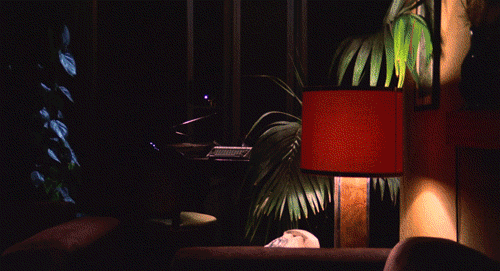
⛲️The film location Quartiere Coppedè area’s unusual and whimsical appearance has inspired several movies, such as “Inferno” and “The perfume of the lady in black” More recently, House of Gucci with Lady Gaga. The film progresses slowly, but you can admire its colors and staging.

🎨“On the The Perfume of the Lady in Black DVD special feature Barilli admits that the idea for the film came from one of his paintings of the titular lady in black, seated with her back against the viewer, a painting seen in the film and which cuts the subject as a sad, lonely figure, a theme which is also established across many of the key characters.”1

After the clairvoyant session, more and more real memories start to come to her mind.

🛖“Francesco Barilli: Well, first of all the basic idea for the film came when I was in Africa, watching a black magic ceremony in Belgian Congo. My mother-in-law passed away during the shooting, then the old man who played the concierge in the film died, too. Well, better not to mess up with black magic…”2

The plot shouldn't be revealed too much, but not everything is as it seems.

🐦⬛“FB:Look at Hitchcock’s films! I think every director should keep him in mind when making a giallo. I don’t mean to copy him, De Palma-style: you have to study the way he builds up every scene, every single shot, the way he dresses actors and makes them move…”2

🍖“Francesco Barilli: Well, I really loved Polanski films, especially Repulsion and Rosemary’s Baby. Anyway, The Perfume of the Lady in Black was born in quite a unique way, because, you see, there were these two scripts I’d written: one was the story of a schizophrenic woman, while the other was about a cannibal sect in Geneva…”2
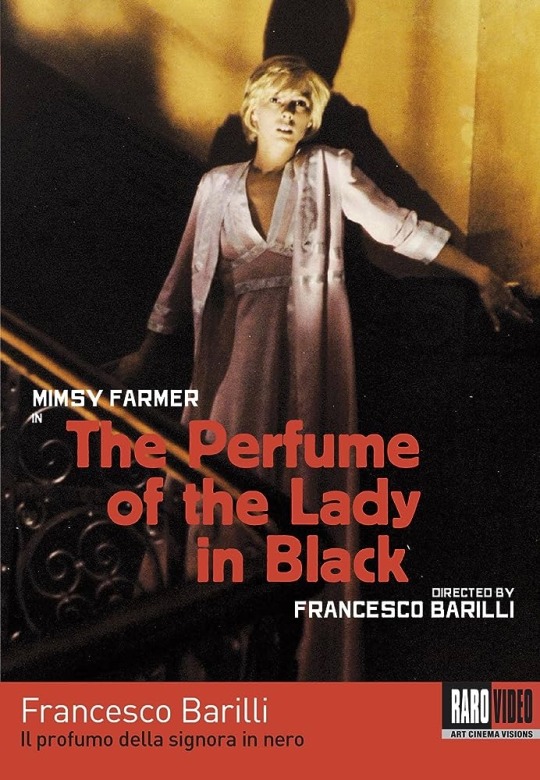
An interesting trip down the rabbit hole⭐️⭐️⭐️

1.Francesco Barilli’s Dual Gems
Donato Totaro Off Screen, Issue 12.
2. Francesco Barilli Interview
Cinema Between Brush Strokes
by Roberto Curti same issue
🚨SPOILER ALERT 🚨 Trailer reveals too much!!!!!!
youtube
#witchcraft#movies#witch#cinema#witches#horror film#giallo#gialli#italian horror#film#horror#psychology#Youtube
22 notes
·
View notes
Text
Come feci per le Olimpiadi di Tokyo 3 anni fa, arriva il riassuntone delle medaglie conquistate dalla spedizione italiana.
Ma prima, un po' di "menzioni speciali": mai come quest'anno, infatti, ci sono stati così tanti piazzamenti al quarto posto per gli atleti italiani...
4️⃣ Giovanni Abagnale (canottaggio 4 con)
4️⃣ Domenico Acerenza (nuoto di fondo 10km)
4️⃣ Fabio Balaso (pallavolo)
4️⃣ Elisa Balsamo (inseguimento squadre)
4️⃣ Elena Bertocchi (tuffi 3m sincro donne)
4️⃣ Mattia Bottolo (pallavolo)
4️⃣ Alessandro Alberto Bovolenta (pallavolo)
4️⃣ Luca Braidot (MTB corsa)
4️⃣ Tammaro Cassandro (skeet)
4️⃣ Martina Fidanza (inseguimento squadre)
4️⃣ Gianluca Galassi (pallavolo)
4️⃣ Simone Giannelli (pallavolo)
4️⃣ Larissa Iapichino (salto in lungo)
4️⃣ Lamont Marcell Jacobs (atletica 4x100m uomini)
4️⃣ Nicholas Kohl (canottaggio 4 con)
4️⃣ Daniele Lavia (pallavolo)
4️⃣ Matteo Lodo (canottaggio 4 con)
4️⃣ Lorenzo Marsaglia (tuffi 3m sincro uomini)
4️⃣ Matteo Melluzzo (atletica 4x100m uomini)
4️⃣ Alessandro Michieletto (pallavolo)
4️⃣ Letizia Paternoster (inseguimento squadre)
4️⃣ Lorenzo Patta (atletica 4x100m uomini)
4️⃣4️⃣ Chiara Pellacani (tuffi 3m sincro donne, tuffi 3m trampolino)
4️⃣ Riccardo Pianosi (vela kite)
4️⃣ Benedetta Pilato (100m rana)
4️⃣ Luca Porro (pallavolo)
4️⃣4️⃣ Simona Quadarella (800m stile, 1500m stile)
4️⃣ Yuri Romano (pallavolo)
4️⃣ Roberto Russo (pallavolo)
4️⃣ Giovanni Sanguinetti (pallavolo)
4️⃣ Riccardo Sbertoli (pallavolo)
4️⃣ Stefano Sottile (salto in alto)
4️⃣ Massimo Stano (marcia 20km)
4️⃣ Giovanni Tocci (tuffi 3m sincro uomini)
4️⃣ Filippo Tortu (atletica 4x100m uomini)
4️⃣ Giuseppe Vicino (canottaggio 4 con)
E adesso, l'elenco delle medaglie (e di altri quarti posti...) come da protocollo:
🥈 Angela Andreoli (artistica squadre)
🥇 Ekaterina Antropova (pallavolo)
🥇 Diana Bacosi (skeet squadre miste)
🥇 Caterina Marianna Banti (multiscafo misto)
🥈4️⃣ Nadia Battocletti (atletica 10000m, atletica 5000m)
🥇 Alice Bellandi (judo -78kg)
🥈 Guillaume Bianchi (fioretto squadre)
🥇 Caterina Chiara Bosetti (pallavolo)
🥇 Carlotta Cambi (pallavolo)
🥈 Gabriele Casadei (canoa sprint doppio 500m)
🥇🥉 Thomas Ceccon (100m dorso, 4x100m stile uomini)
🥉 Martina Centofanti (ritmica all-around squadre)
🥈 Luca Chiumento (canottaggio 4 di coppia)
🥇4️⃣ Chiara Consonni (madison, inseguimento squadre)
🥈🥉 Simone Consonni (madison, inseguimento squadre)
🥉 Paolo Conte Bonin (4x100m stile uomini)
🥇🥈4️⃣ Alice D'Amato (artistica trave, artistica squadre, artistica all-around)
🥇 Anna Danesi (pallavolo)
🥇 Giovanni De Gennaro (kayak singolo)
🥇 Monica De Gennaro (pallavolo)
🥉 Andy Diaz Hernandez (salto triplo)
🥉 Agnese Duranti (ritmica all-around squadre)
🥇 Paola Ogechi Egonu (pallavolo)
🥇 Sara Errani (tennis doppio donne)
🥈 Arianna Errigo (fioretto squadre)
🥈🥉 Manila Esposito (artistica squadre, artistica trave)
🥇 Sarah Luisa Fahr (pallavolo)
🥈 Martina Favaretto (fioretto squadre)
🥇 Rossella Fiamingo (spada squadre)
🥉 Manuel Frigo (4x100m stile uomini)
🥈 Alessio Foconi (fioretto squadre)
🥉 Mattia Furlani (salto in lungo)
🥈🥉 Filippo Ganna (ciclismo cronometro individuale, inseguimento squadre)
🥈 Giacomo Gentili (canottaggio 4 di coppia)
🥇 Gaia Giovannini (pallavolo)
🥇4️⃣ Vittoria Guazzini (madison, inseguimento squadre)
🥈 Elisa Iorio (artistica squadre)
🥉 Francesco Lamon (inseguimento squadre)
🥇 Marina Lubian (pallavolo)
🥈🥈 Filippo Macchi (fioretto individuale, fioretto squadre)
🥇 Marta Maggetti (windsurf)
🥉 Giorgio Malan (pentathlon moderno)
🥉 Alessia Maurelli (ritmica all-around squadre)
🥈 Federico Nilo Maldini (pistola 10m)
🥈 Tommaso Marini (fioretto squadre)
🥇 Nicolò Martinenghi (100m rana)
🥉 Jonathan Milan (inseguimento squadre)
🥉 Alessandro Miressi (4x100m stile uomini)
🥉 Daniela Mogurean (ritmica all-around squadre)
🥉 Paolo Monna (pistola 10m)
🥉 Lorenzo Musetti (tennis singolo)
🥇 Mara Navarria (spada squadre)
🥇 Oghosasere Loveth Omoruyi (pallavolo)
🥈 Stefano Oppo (canottaggio 2 di coppia)
🥇 Alessia Orro (pallavolo)
🥈🥉 Gregorio Paltrinieri (1500m stile, 800m stile)
🥈 Francesca Palumbo (fioretto squadre)
🥈 Andrea Panizza (canottaggio 4 di coppia)
🥇 Jasmine Paolini (tennis doppio donne)
🥉 Laura Paris (ritmica all-around squadre)
🥉 Antonino Pizzolato (sollevamento pesi 89kg)
🥉 Sofia Raffaeli (ritmica all-around individuale)
🥈 Luca Rambaldi (canottaggio 4 di coppia)
🥇 Giulia Rizzi (spada squadre)
🥇 Gabriele Rossetti (skeet squadre miste)
🥉 Luigi Samele (sciabola individuale)
🥇 Alberta Santuccio (spada squadre)
🥉 Alessio Simone (taekwondo -80kg)
🥈 Gabriel Soares (canottaggio 2 di coppia)
🥈 Silvana Maria Stanco (trap)
🥇 Myriam Fatime Sylla (pallavolo)
🥈 Carlo Tacchini (canoa sprint doppio 500m)
🥉 Ginevra Taddeucci (nuoto di fondo 10km)
🥇 Ruggero Tita (multiscafo misto)
🥈 Giorgia Villa (artistica squadre)
🥈 Elia Viviani (madison)
🥈4️⃣ Alice Volpi (fioretto squadre, fioretto individuale)
Anche stavolta, la grande domanda: di loro, di tutti loro, ve ne ricorderete a lungo... O già questo sabato sarete ad imprecare contro lo streaming che non funziona per vedere altri "sportivi"?
#olimpiadi#olympics#riassuntone#medaglie#medaglie di legno#sport#sport italiano#perché non c'è solo il calcio
6 notes
·
View notes
Text

Baco
Michelangelo Merisi, conocido como Caravaggio (Milán 1571 - Porto Ercole 1610)
Hacia 1598
Pintura al óleo sobre lienzo
95x85 cm
Inventario 1890 n. 5312
La pintura forma parte de la primera serie de medias figuras pintadas "en claro" que incluye obras como el "Fruitman" de la Galería Borghese de Roma, el "Niño mordido por un lagarto verde" de la Fundación Longhi de Florencia, el "Canasta de frutas" de la Pinacoteca Ambrosiana de Milán. Caravaggio, protagonista en Roma en la primera década del siglo XVII de una revolución pictórica que invadió toda Europa, muestra en esta obra una interpretación magistralmente naturalista del mundo vegetal. Sorprende la interpretación de la cesta de frutas y de la copa de vino ofrecida por Dios, pasajes entendidos por algunos estudiosos como una invitación horaciana a la vida frugal, la convivencia y la amistad. La figura escultórica de Baco, con su expresión aturdida por el vino, está ejemplificada en modelos del arte clásico, en particular en los retratos de Antínoo, y parece imbuida de una lánguida sensualidad. Mina Gregori leyó en él una particular visión de la antigüedad alabando la libertad de los sentidos y una referencia a los ritos iniciáticos y disfraces báquicos que se practicaban en Roma. Hallada en los depósitos de los Uffizi en 1913 y atribuida a Caravaggio por Roberto Longhi, la obra hace referencia a la actividad aún juvenil del pintor, cuando, en Roma, se encontraba bajo la protección del cardenal Francesco Maria del Monte. Este cuadro, junto con la Medusa (inv. 1890 n. 1351), fue donado por el cardenal del Monte a Fernando I de Médici con motivo de la celebración de la boda de su hijo Cosme II en 1608.
Información de la web de la Gallerie degli Uffizi, imagen/es de mi autoría.
13 notes
·
View notes
Text
Italian literature tournament - First round (start Monday 21 October - end Sunday 10 November).

Boccaccio reading from the Decameron to Queen Johanna of Naples, Gustave Wappers, 1849.
👉 There you go the official list with the pairs of the authors for the first round, all the combinations have been randomly created.
👉 Each pair has its link to the apposite poll to vote, that start to function when the poll start. Each poll have a duration of 1 week. In any case don't worry, each poll is tagged with the name of the author featured so you can find it also with the search bar.
👉 Every poll completed, the result will be posted in the same row - the winning author signed in bold.
Elio Vittorini - Gianni Rodari
Giacomo Leopardi - Carlo Levi
Beppe Fenoglio - Giovanni Boccaccio
Anna Banti - Giosuè Carducci
Elena Cassandra Tarabotti - Cletto Arrighi
Goffredo Parise - Antonio Fogazzaro
Matilde Serao - Ugo Foscolo
Sibilla Aleramo - Dante Alighieri
(Carlo) Fruttero & (Franco) Lucentini - Luigi Pulci
Francesco Petrarca - Gabriele D'Annunzio
Pietro Bembo - Jacopo Sannazaro
Giovanni Verga - Giambattista Basile
Pietro Metastasio - Primo Levi
Dino Buzzati - Alba de Céspedes
Pier Paolo Pasolini - Veronica Franco
Carlo Cassola - Salvator Quasimodo
Lalla Romano - Amelia Rosselli
Umberto Saba - Jacopone da Todi
Gaspara Stampa - Mario Rigoni Stern
Goliarda Sapienza - Luigi Capuana
Pier Vittorio Tondelli - Tullia d'Aragona
Cecco Angiolieri - Dario Fo
Carlo Emilio Gadda - Giuseppe Tomasi di Lampedusa
Federico de Roberto - Antonio Tabucchi
Vittoria Colonna - Alessandro Manzoni
Francesco Guicciardini - Giacomo/Jacopo da Lentini
Giorgio Scerbanenco - Pietro Aretino
Giovanni Meli - Igino Ugo Tarchetti
Giovan Battista Marino - Torquato Tasso
Giorgio Bassani - Angelo Poliziano
Giovanni Pascoli - Natalia Ginzburg
Matteo Bandello - Leonardo Sciascia
Giuseppe Parini - Luciano Bianciardi
Renata Viganò - Carlo Collodi
Eugenio Montale - Cesare Pavese
Anna Maria Ortese - Vittorio Alfieri
Italo Svevo - Umberto Eco
Matteo Maria Boiardo - Ludovico Ariosto
Cielo (Ciullo) d'Alcamo - Giuseppe Ungaretti
Guido Gozzano - Carlo Goldoni
Sebastiano Vassalli - Tommaso Landolfi
Edoardo De Filippo - Emilio Salgari
Giordano Bruno - Andrea Camilleri
Alberto Moravia - Alda Merini
Elsa Morante - Italo Calvino
Niccolò Machiavelli - Grazia Deledda
Carlo Gozzi - Guido Cavalcanti
Luigi Pirandello - Ennio Flaiano
63 notes
·
View notes